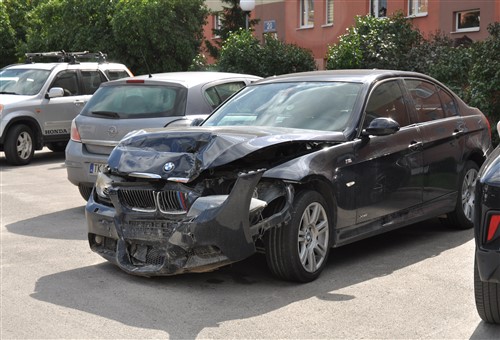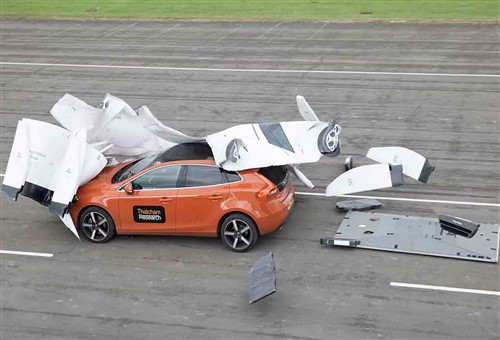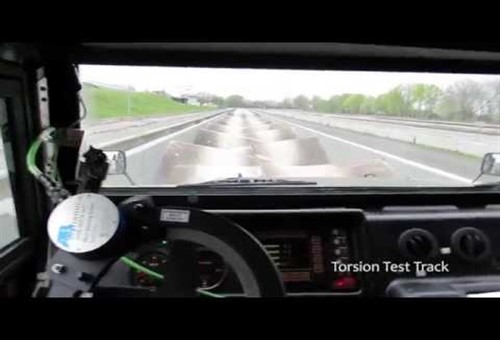
You may be surprised to learn that AEB (Automatic Emergency Braking), which is an ADAS system that was expressly designed to prevent or mitigate accidents like the rear-end collision this high-end car was involved in, is the least effective ADAS system now in use. In fact, even though AEB is now a legal requirement on all cars made and sold in the USA, this system has a shockingly low success rate in preventing or mitigating rear-end collisions or colliding with obstacles crossing the vehicle's path. Worse, though, ASB performs particularly poorly when it comes to avoiding collisions with pedestrians and cyclists.
We covered the shortcomings of AEB in a previous article, so we need not rehash the finer details of the independent tests that demonstrated the weaknesses of these systems here. Suffice it to say, though, that along with all other ADAS systems in use today, AEB systems conform to a set of internationally recognized standards that define the operating and functional parameters of ADAS systems.
So, since the purpose of ADAS systems is to prevent or mitigate accidents as a means to prevent injuries and save lives, it would not be unreasonable to ask how car manufacturers test ADAS systems and the technologies that underpin their operation before these systems are implemented at large scales. In this article, we will take a closer look at how ADAS systems are tested before implementation, but before we get to specifics, it might be worth mentioning the-
While car manufacturers in all markets are free to call their individual ADAS offerings whatever their marketing departments feel will resonate with potential buyers of new vehicles, all car manufacturers in all markets are legally obliged to follow the prescripts of literally hundreds of standards when they a) design an ADAS system, and b) when they adapt an existing ADAS system to perform multiple roles. An example of this would be Adaptive Cruise Control and Lane Keep Assist, whose components are used to support Automatic Emergency Braking.
We obviously cannot list hundreds of documents that each describe some aspect of an ADAS systems design and implementation here, but we can do the next best thing, which is to list the various regulatory bodies and organisations that develop ADAS standards. Below is a list of the principal organizations-
In the case of Australia, ADAS and other automotive safety standards are enforced by the National Transport Commission through the government’s Department of Infrastructure, Transport, Regional Development, and Communications, which oversees and administers the Australian Design Rules.
The current iteration of the Australian Design Rules is enshrined in the Motor Vehicle Standards Act of 1989, which was enacted expressly to bring all automotive standards in force in Australia into harmonization with international regulations of the UN, wherever such harmonisation is possible or practicable. Note that this applies to all vehicles on Australia’s roads, regardless of where they were built or assembled.
In practice, the above means that all ADAS components on vehicles on our roads comply with internationally recognized (and legally enforceable) standards that prescribe, among many other things, the following-
- and, as we said, a great many other things. Nonetheless, the point we want to make is that whenever we run into diagnostic or calibration issues on any given ADAS system, it helps to know that standard problems will (almost always) have standard solutions. Put differently, this means that say, a misaligned radar or lidar transponder will always affect all the ADAS systems on that vehicle that depend on the radar or lidar transponder to be properly aligned to work. Therefore, recalibrating or aligning the radar or lidar transponder strictly according to OEM procedures will almost always resolve multiple trouble codes relating to ADAS systems that depend on the correct alignment of the transponder.
So, with that out of the way, let us look at-

Image source: https://www.datocms-assets.com/53444/1665992467-adas-testing-proving-ground.jpg?auto=format&w=1200&dpr=1.5
Although the design and much of the initial testing of an ADAS system (or the technical implementation of an existing ADAS system on a new vehicle model) is done by computer modelling and running simulations on near-super computers, actual wheels-on-the-ground testing is done on one or more of about 40 purpose-built test tracks around the world, including one in Australia.
While test tracks offer several advantages, the problem for researchers and engineers is that it is impossible to replicate real-world driving conditions on a test track. Nonetheless, since researchers and engineers are acutely aware of this, they have developed equipment and test protocols that can mimic and repeat any response or reaction a human driver might have to a dangerous situation hundreds or even thousands of times. Moreover, most test equipment, such as driving robots, can repeat the same action an infinite number of times in exactly the same amount of time, which ensures consistently reliable and predictable baseline data.
Eliminating a human test driver requires that test vehicles must be equipped with data acquisition hardware that is linked wirelessly to one or more so-called ground stations from which the vehicle can be controlled as if it is controlled by a human driver in real-world driving conditions. Set-ups like these are roughly analogous to flight simulators, in the sense that a pilot undergoing training has to deal with situations that are imposed from an external source, i.e., an instructor that can introduce various potentially dangerous flight conditions via an external computer.
Having said that, below is a partial list of the most commonly used test equipment-
In some cases, ADAS testing may involve only a single vehicle, while some types of tests may require that several vehicles move around the test track at the same time to simulate some real-world driving conditions. Regardless of the number of vehicles that are on the test track at any given time, when a test vehicle is configured correctly, it is possible to test the reaction(s) of one or more ADAS systems in the test vehicle to common driving hazards and situations all drivers encounter daily, such as the following-
As we know, there are many other hazards we all face while driving in real-world conditions, but from the perspective of test engineers, the four hazards we listed above represent an almost unlimited number of possible variations and permutations. Of course, no human brain can ever foresee all possible reactions to all possible situations, so the object of testing ADAS systems is not about developing software to enable all ADAS systems to react to all possible situations under all possible conditions.
As a practical matter, testing ADAS systems is about using mathematical models to develop software, sensors, and other hardware that will ensure that the ADAS systems in production vehicles will react predictably and consistently in the same manner in some situations. Such situations could include-
There are many other examples we could list here but that would be beside the point. The point is that ADAS systems can only react to situations that design and test engineers can foresee based on currently available information on the most common causes of traffic accidents, as opposed to all possible causes of traffic accidents- many of which involve drivers trying to defy the laws of physics.
We can put the above into perspective by saying that as a technology, ADAS systems cannot predict events; ADAS systems can only react to events or changing circumstances as they develop in real-time. For instance, even though most of the latest iterations of adaptive cruise control systems take into account much more in a driving environment than just the position of the vehicle they are locked onto, no adaptive cruise control system can predict or "foresee" the moment when the leading vehicle might suddenly slow down for whatever reason.
All that the cruise control system in the following vehicle can do is react to the decreasing distance between the two vehicles as it occurs in real-time. However, the efficiency of the adaptive cruise control system in the following vehicle depends on at least the following factors-
Of course, the more systems and control modules that are involved, the more courses of corrective action become available, but here is the thing: the number of available courses of corrective action is limited to the number of variables that are programmed into all control modules with ADAS functionalities. For the most part, modern iterations of adaptive cruise control systems can avoid rear-ending leading vehicles with a high degree of certainty, but if say, a leading vehicle suddenly stops and begins to reverse at high speed, there might not be enough time for the ADAS systems in the following vehicle to avoid the leading vehicle reversing into the following vehicle.
So, the testing of modern ADAS systems in controlled environments is crucially important to ensure that all the ADAS systems that are fitted to a vehicle can work in conjunction to avoid, or at least mitigate the accidents and collisions that might arise from foreseeable causes, such as (for example) vehicles drifting out of their respective driving lanes, or drivers that do not maintain a steady driving speed.
At the risk of putting too fine a point on things, it is against the background of foreseeable causes of traffic accidents that ADAS systems are programmed, and undergo extensive testing to ensure that the programming works as expected and intended. Having said that, let us look at how some test equipment is used to test whether (or not) ADAS systems work as expected-
Driving robots

Image source: https://dewesoft.com/blog/how-are-adas-systems-and-autonomous-vehicles-tested
This image shows how a driving robot “sees” a test track during a test procedure. For more views of how driving robots control vehicles during ADAS testing, we recommend that you watch this video.
Equipping a test vehicle with a driving robot does not require that the vehicle’s standard controls and airbags or other driver restraints be removed or modified in any way. In most cases, driving robots can fulfil the functions a human driver would; these robots activate the steering, all pedals, as well as gear selectors and other controls.
As a practical matter, modern steering robots can be programmed to perform all the driving operations a human driver a) encounters while driving, and b), perform all the driving operations a human driver might be required to perform during driving. These operations include but are naturally not limited to making lane changes, avoiding obstacles, following a leading vehicle at a safe distance, or maintaining the vehicle’s distance from other vehicles in adjoining driving lanes.
Depending on the test being conducted, test engineers can induce potentially dangerous situations by, for example, deliberately applying excessive amounts of oversteer and acceleration during a short-angle lane change to induce a slide.
Thus, if the programming of systems like stability control, autonomous steering, and active suspension is valid and free of bugs, the test vehicle will activate these and other systems to correct the slide and restore the vehicle's stability and controllability. Note that while tests of this kind typically require the presence of a human driver in the vehicle to assume control of the vehicle should the test equipment, or worse, the ADAS systems being tested fail, the human driver is prohibited from touching any controls except in dire emergencies.
In practice, the advantage of using driving robots instead of human drivers is that robots can respond to input commands with a degree of accuracy and repeatability that no human driver can emulate, which makes it possible to perform NHTSA-mandated roll-over tests, as well as Fishhook and J-Turn, UN Reg 13-H / FMVSS 126 sine-dwell tests, and others as many times as required with a high degree of precision, which brings us to-
Data acquisition and analysis
Although the terms Inertial Measurements Units (IMUs) and Inertial Navigation Systems (INS) are often used interchangeably, these terms are for the purposes of ADAS testing, two faces of the same coin, so to speak.
In practice, one side of the coin (IMUs) uses devices like accelerometers, gyroscopes, and often magnetometers to produce signals that the other side of the coin (INSs), use to calculate things like linear velocity, linear position, angular rates of acceleration/deceleration, and several more parameters, including gravitational forces.
This information is then relayed to one or more ground stations via robust wireless links for analysis. The main focus of the analysis is to see a) how a vehicle reacts to an induced condition such as a slide, and b) see if the relevant ADAS systems in the test vehicle can both respond to the slide and initiate appropriate corrective action(s) in time to avoid or mitigate a collision with another vehicle or an object, such as a pedestrian or cyclist.
Based on the results of the analysis, one or more of the following could happen-
This kind of “tweaking” of one or more ADAS systems could take several months, but given the huge costs involved, ADAS systems are typically only tweaked until they perform satisfactorily on a statistically significant number of production vehicles, as opposed to working perfectly on all production vehicles. Of course, this explains why we sometimes see defects and failures in some ADAS systems that defy rational explanations. So now, you know why this happens.
It is worth mentioning that the positions and movements of ADAS targets in the form of remotely controlled human-like dummies and inflatable or lightly constructed vehicles that are mounted on flat skateboard-like platforms are also monitored and measured to the nearest 20mm or so. This subset of data allows researchers and test engineers to calculate and/or infer parameters like impact forces and the potential for real human targets to sustain injuries during real traffic accidents, which leaves us with this-
Despite their shortcomings, there is no doubt that ADAS systems have prevented hundreds of thousands of accidents and saved thousands of lives across the globe over the past 20 or so years. However, since most ADAS systems are both highly complex and deeply integrated into each other, it is up to us, as mechanics and technicians, to learn as much as possible about these systems function and how the failure of one ADAS system can and often does affect the operation of other, closely related ADAS systems.
Based on the above, we hope that this article has given you some new insights into why seemingly avoidable accidents still happen despite the proliferation of ADAS systems on new vehicles. In this regard, it is worth repeating that ADAS systems are neither designed nor intended to prevent all accidents. ADAS systems are designed and intended to prevent some accidents most of the time, which means that we have a special responsibility to ensure that we do not compromise the operation of any ADAS system on our customer’s vehicles when we service and/or repair their vehicles.